| Mills were built all
over Crete but it is only in Lassithi County that so many have survived.
Especially at the entrance to the Lassithi plateau and on the Mirabello
peninsula stand many old windmills from the period 1850-1940. Only a few
of them are still in use while the rest are in a miserable condition.
|
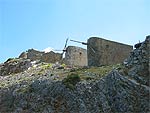
|
|
|
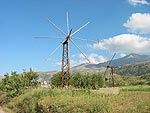 |
The Lassithi plateau is famous
for its many small windmills which earlier pumped up irrigation water from
the subsurface. But today they have to a great extent, been replaced by
electrical or petrol powered pumps. So the mills have been left to fall
into disrepair as there were not enough qualified workmen to repair them
either. |
|
|
| In addition to the pump-mills
the plateau is known for its larger mills where the farmers had their
grain ground. On the ridge of the Seli Ambelou pass where the road from
Iraklion leads into the plateau, no less than 24 of the old mills stand in
a row. |
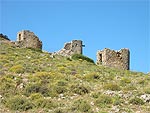
|
|
|
|
| It is characteristic of the
mills that they had no cap that could turn after
the wind direction. For that reason the mills could only function when the
wind came from the northwest (meltemi). But the meltemi is exactly the
prevailing wind in summer and autumn when the corn was ground.
|
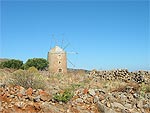 |
Besides, the mills without revolving caps were considerably cheaper to build than those with revolving caps of which there only a few may be seen, for
example at Elounda and Schinias on the Mirabello peninsula. |
|
|
| The flour that the farmers used
in winter was ground already in autumn, because winter was a busy period
with the time-consuming olive picking and the subsequent pressing.
Furthermore, it was often impossible or very difficult to take the grain
to the high situated mills because of the large amounts of snow. |
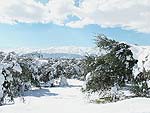
|
|
|
*** |
|
|
| The cap-less mills are
also called horseshoe-shaped because their front is rounded to lighten the
passage of the wind.
|
| They were built of local stones
and the walls were often more than ½ m thick to be proof against the
blasts of wind and to hold the heavy grinding mill.
|
| There are both single-storied
and two-storied mills. In the two-storied mills, the lower floor was used
as a storeroom while an external flight of stone steps led up to the top floor where the actual grinding mill was placed.
The door was in the opposite side from the sails but in a few mills it was,
however, placed in the side wall.
|
| Some projecting stones were
placed in the outer wall to function as steps when the roof of the mill
needed mending. Despite the strong walls of the mills, the flat roof,
sloping slightly to the rear, was constructed in the same way as on the
ordinary houses i.e. a layer of rafters and laths were covered with dried
shrubs and sealed with clay. A roof like that had to be mended every
second year as the clay often started to crack and allowed rainwater to
penetrate. |
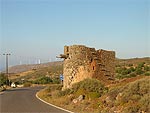
|
|
|
|
|
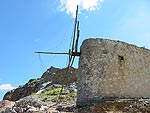
|
The axle, or
wind shaft, (xóni) made of a thick oak trunk, was extended with an about
3 m long pole (daliamás or xárti). |
|
|
|
| The wings consisted of 10 sails
tied to wooden bars which were fixed, staggered, to the wind shaft. The bars were tied together and were moreover secured to the point of
the daliamás in order to give greater stability |

|
|
|
|
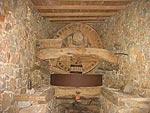
|
The shaft rested partly in the
frame of the cap-wheel (dakoúni)
and partly in a casing (trápeza)
on a thick transverse oak trunk. When the wings were spinning, the shaft
and the cap-wheel were spinning too. The cap wheel was provided with a
metal sprocket which had to be lubricated with a soap mixture to reduce
the friction.
|
| The cap-wheel (róda)
was provided with 52 poles (dódia)
which directly activated the pole pinion which again powered the top
millstone (panópetra = the runner). Both the cap wheel and the pole pinion
was made of plane wood.
|
| Millstones made out of one big
stone exist, but they generally consisted of quite a few (30-60)
rough-hewn stones held together in a strong mortar mixture and encircled
by an iron band. The millstones had a diameter of 1,5-2 m, were about 40
cm thick and had a life span of about 30 years.
|
| The top millstone was moreover
connected to a lifter (anevátis) so that the miller was able to adjust
the distance between the two stones and separate them when the grooves had
to be sharpened after a couple of month's use. It was a time-consuming job
which took a entire working day. In order to clean the newly sharpened
stones, the first thing to be ground was an amount of barley which was
used as animal feed.
|
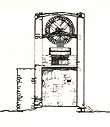
|
| The lower millstone was placed firmly on two low walls between which the
container (alevrodóchi) for picking up the
fresh-ground flour was placed. A mill could on average grind 600-700 kg of
fine flour in 12 hours.
|
|
***
|
|
|
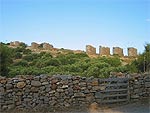
|
As it was very expensive to
build a mill, it was forbidden by law to build other mills nearby if they could set up a wind turbulence which would reduce the
wind to the existing mill. It was also forbidden to plant trees near the
mill.
|
| Many mills were owned
by the miller himself but some were let on lease to another person who
took care of the day-to-day operations. The lessee paid the owner in one
of the following three ways: 1) a fixed arranged rent paid in kind or in
cash, 2) "tritáriko" where the owner got two
thirds of the earnings and the lessee the last third, 3) "symisakó"
where the owner and the lessee divided the earnings. As payment for the
grinding, the farmers paid 10% of the grain to the miller.
|
|
***
|
|
|
| When the wind was favourable the miller opened a couple of the sails of the mill,
and the farmers were able to see from the distance that they could have
their corn ground that day.
|
| Usually the farmers came to the
mill once a month to have about 60 kg of corn ground. Before they set out
for the mill they had to clear the corn of stones, earth and other
impurities.
|
| They arrived from the nearby
villages leading their donkeys loaded with corn in two hampers (gomária)
on each side of the animal and a sack (panogómi) over the animal's back.
In addition the women often brought 10 kg of wheat which was ground
separately (xálesma) and used for production of macaroni.
|
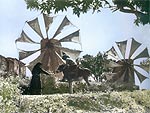
|
| At the mill the corn was
unloaded, poured into sacks and weighed, and the miller wrote the weight
and the name of the owner - either on a piece of paper or directly on the
sacks with a stick of chalk. Depending on how busy the miller was, the
corn was ground the same day or one of the following days.
|
| If the farmers came from far
away they often waited at the mill until their flour was ready which also
gave the miller an opportunity to hear news from other areas.
|
|
|
|
|




